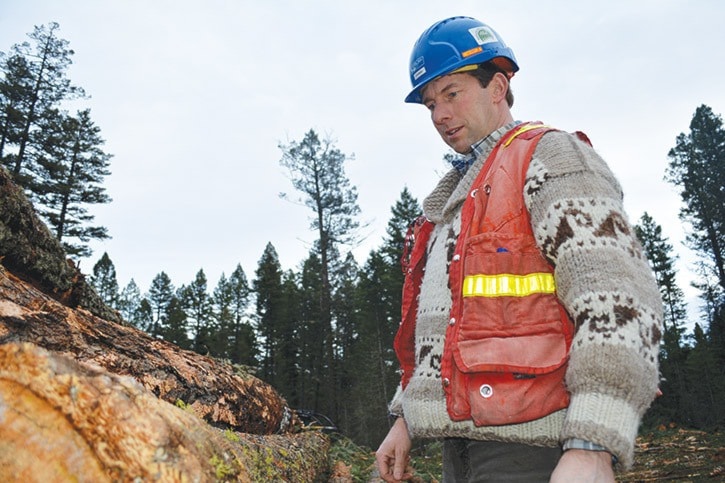For the last six years the community of Esket (Alkali Lake) 45 minutes south of Williams Lake has been building capacity to manage the land.
“It’s our number one focus,” said Gord Chipman, the forester who manages Alkali Resource Management (ARM).
In 2001 Esket was awarded the second community forest in the province and this coming March will see it renewed for another 25 years.
“In the community forest we manage 30,000 hectares,” Chipman said. “Half of it is mule deer winter range which from a harvesting and silviculture perspective has lots of restrictions.”
Currently ARM is working on creating another tenure in the form of a First Nations Woodlands Licence which would give the band an additional 60,000 hectares.
“We’ve been working on that application for three years and will hopefully have it awarded by 2016,” Chipman said.
Recently ARM established a joint venture with the First Nation community of Toosey’s Chilcotin Plateau Enterprises Ltd.
Together the two groups are managing the National Defence Area near Riske Creek, identifying cut blocks, logging, and in the near future hopefully tree planting and spacing, Chipman added.
There are 18 people working in ARM’s woodlands department doing planning, timber cruising, timber development by establishing cut blocks and roads.
Spacing supervisor Anthony Robbins said two to four crews of five spacers have been busy this season spacing. They have about 60 hectares of spacing left to do which will be completed in about two months.
“I never really thought I’d be here working in forestry, but I’m busy with the spacing, road building, slash burning and tree planting,” Robbins said.
Bev Hutchinson, ARM’s registered forest technician in training, started off as a secretary and under Chipman’s encouragement tackled other duties until she eventually enrolled in the forestry program at BCIT.
Now the 30-year-old is the company’s harvesting and silviculture supervisor.
She checks the roads and skid trails, organizes the trucking cycles, regulates compliance for old growth management areas and the mule deer winter ranges.
This May 10 community members and Blue Collar Silviculture Ltd. out of Quesnel planted 300,000 trees in the community forest, while 100,000 of those trees came from ARM’s own seeds.
“We picked enough cones from the community forest to plant 25 million trees,” Chipman said. “The seeds are being housed at the Ministry of Forests seed centre in Surrey.”
Francis Johnson grew up at Esket and is ARM’s planning and development forester.
A graduate from Thompson Rivers University in natural resource science, Johnson said his community wants to be independent and have its own economy.
“I’m proud of the fact that since we opened our doors to create opportunities in 2010, three people have gone to school to study resource management,” Johnson said, adding ARM has a scholarship program to send people to school. “We believe we have a great future. This year we had 73 people with records of employment.”
One of the exciting aspects of Johnson’s job is continually learning about the Esket people’s historical and traditional use of the area.
“We found three different village sites, two within the community forest and one adjacent to it,” Johnson said. “We take elders on tours to help us identify the history and settlement patterns.”
Before moving into houses, the people lived in quiggly holes, which along with culturally modified trees, tools and arrowheads have been discovered by researchers and locals.
“We even found a carved trail on the side of a hill,” Johnson said, noting all of these types of areas have to be protected under the heritage act and any recommendations by the band.
“We have four village sites on the west side of the Fraser River too. In fact Esket is actually five or six communities made into one.”
Esket is located in a dry belt Douglas-fir forest, which is perfect for tree spacing, Chipman said.
Two years ago crews removed about 70 per cent of the trees in an area along Place Lake Road that had been logged in the 70s.
The trees at the edge of the forest closest to the road are left intact for about 10 metres, so hunters cannot see into the forest easily, Chipman said.
Esket also jointly owns Ecolink Forest Services with Tolko Industries Ltd. Ecolink recently celebrated 25 years of operation.
In August, loggers began harvesting Douglas-fir beetle infested trees, and of the total 40,000 cubic metres that will be harvested in the community forest this year, three quarters will be beetle attacked trees.
“Ecolink is set up to do 20 logging truck loads a day,” Chipman said.
Pointing to the hillside on the north end of the community forest, Chipman said it looks a lot better than it did in the summer because the red coloured Douglas-fir beetle infected trees have been removed.
“We have been in here for about five years chasing beetle kill. A lot of it came from the Dog Creek fire in 2010.”
Another aspect of the community forest is grassland management.
Core sampling of mud taken from Alixton Lake a few years ago revealed the area was all grasslands thousands of years ago.
Today there are about 1,000 hectares of grasslands within the community forest to manage.
In his personal life Chipman coaches for his son’s team in Williams Lake Minor Hockey.
“My job as manager is a lot like coaching,” he said. “I am here to coach these guys for the future.”
Crediting the support the resource management programs receive locally, Chipman said the community recognizes the difference between business and politics.
“We have an independent board of directors who are not politically driven, but focused on the community,” he said. “Council deals with politics and gives us the license to manage.”
